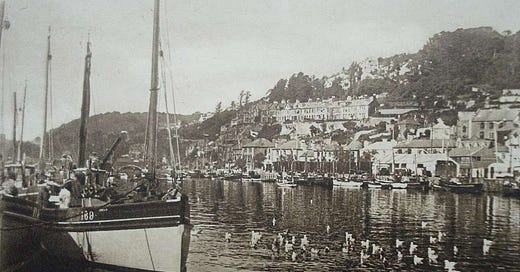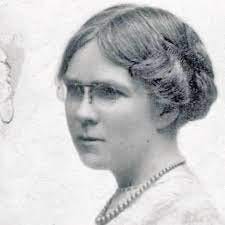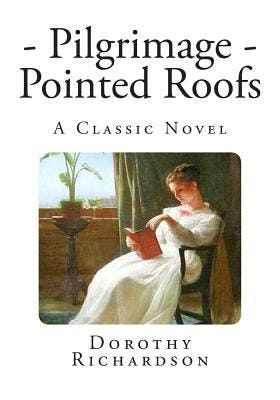Welcome to A Narrative of their Own where I discuss the literature of 20th century women and their relevance to our contemporary culture. If you would like to receive a weekly newsletter into your inbox, as well as a monthly review of other great reading, please consider becoming a free or paying subscriber.
Born in Abingdon just south of Oxford into a middle-class family, modernist writer Dorothy Richardson attended a progressive school in London influenced by the thinking of John Ruskin. Following a down-turn in the family’s financial situation, however, Richardson took work in both Germany and England as a governess and teacher, and later as a dental receptionist in Harley Street in the 1890s and 1900s.
It was at this time that she lived in lodgings in the Bloomsbury area of London, associating with writers, political radicals, and exiled Europeans. Many of these made it into her novel-sequence Pilgrimage including writer HG Wells (as the character of Hypo Wilson), with whom she had a love affair.
Following a miscarriage with Wells’ child, she appears to have gone on to dedicate herself to the craft of writing.
As with many writers of the era, her writing career began with journalism, essays, and reviews, before beginning her Pilgrimage series with the publication of Pointed Roofs in 1915.
Marrying artist Alan Odle in 1917, it appears that his work influenced her own and though not particularly successful in his own lifetime, Odle’s pen and ink drawings are now collectors’ items. The couple spent their summers in London and winters in Cornwall, eventually basing themselves permanently in Cornwall, where Richardson remained following Odle’s death.
Richardson was amongst the group of writers who began a revolution in literature which became known as the modernist movement.
Many social, cultural, and political aspects influenced the developing modernist movement of the early part of the 20th century, not least the advent and catastrophic tragedies of the first world war, as well as gender and feminist thought. Art and literature began to represent the fracturing of a society trying to come to terms with its losses.
Many writers emerging within this landscape looked to new ways of representing the realities of a new world, starting with ridding themselves of the old, baggy, 19th century tomes written by realist authors like Henry James. Nevertheless, newly emerging modernist writers such as Virginia Woolf still referenced these texts as influential on their work, and utilised such literary techniques to begin to carve out their own aesthetic.
Modernist writers such as Marcel Proust, William Faulkner, and James Joyce began to write prose and poetry which dealt with this fragmentation of society as a way of making sense of it. Whilst still dealing with realist elements of style and structure, they believed in the aesthetics of art over more realist portrayals. The term ‘art for arts’ sake’ developed from this new movement, with a belief that the beauty of the writing – the language and structure of it - was the key to making worthy art.
Dorothy Richardson shared similarities with the writing of Virginia Woolf, and although Woolf is arguably the more recognisable of the two women, Richardson’s Pointed Roofs appeared seven years before Woolf’s experimental novel Jacob’s Room. Both adopted a new tradition through the modernist aesthetic and were early proponents of this, whilst borrowing from older, more male-centric modes of writing. The modernist mode also helped the female writers known as the New Woman novelists to develop their own style.
One of the areas on which Richardson and Woolf differed were their ideas around gendered writing. Woolf insisted on the positive adoption of an androgynous way of writing, her thinking being that men and women needed to transcend this so-called ‘feminine voice’. Richardson meanwhile appears to have diverged from this idea, seeing the more traditional feminine voice used to explore women’s experience as the more favourable choice, whilst still adopting the modernist thematic structure.
Richardson’s Pointed Roofs reads in the same modernist vein as that of Woolf’s Mrs Dalloway with its stream of consciousness style. This led to writer and critic May Sinclair’s first known coining of the term ‘stream of consciousness’, a term previously term associated with psychology, not literature. Richardson however was reportedly unhappy with Sinclair’s use of the term, denying that her work was a novel at all, preferring to see her novel-sequence as gradually developing its own aesthetic without a natural ending or narrative resolution.
Richardson was influenced by a range of bohemian ideas circulating within the milieu she found herself in, amongst them feminism, vegetarianism, and socialist thinking, taking influence from, amongst others, transcendentalist Ralph Waldo Emerson and homosexual rights advocate Edward Carpenter.
Importantly, Pilgrimage, along with much of Richardson’s work, was influenced by her concerns on women’s work and art, and unlike her modernist contemporaries, Richardson had experienced years of poverty, further influencing her work.
After her experience of working for £1 a week in London at the turn of the century, her semi-biographical novel-sequence follows the story of Miriam Henderson from childhood to her formation as a writer. London life and public spheres figure largely within the novel, whilst allowing for her to learn more about both herself and the city. Her protagonist is hostile to the notions of 19th century conventions of femininity as she seeks a new and evolving space in which to claim her own identity.
Richardson’s Pilgrimage novel-sequence contains a remarkable 13-volume, semi-autobiographical narrative that was a seminal example of introspective modernist experimentation. But more importantly, it represents the real-life struggles (and successes) of a single female worker within turn-of-the-century London.
In a fascinating study, critic Hilary Newman suggests that 19th century writer Charlotte Brontë’s earlier novel Villette had a major influence on Richardson’s modernist novel-sequence.
Stressing the autobiographical content of both novels, she focuses more specifically on the first chapter-novel in the sequence, Pointed Roofs, referring to events and technical aspects such as narrative techniques, imagery, and punctuation. Referencing Woolf’s thoughts that many women novelists of the era ‘think back through their mothers’, Newman suggests that aside from Richardson’s novel borrowing from the earlier author’s tradition, so Brontë’s novel anticipated the coming modernist aesthetic.1
In 1979, Pilgrimage was re-issued by Virago as a feminist classic. What I continue to find so remarkable in my study of women’s literature of this era are the ways in which they connect to the issues and ideas that still plague our modern society.
From Richardson’s observations of the low-paid working-class woman, to her narrator Miriam Henderson’s search for her own identity in which to thrive, we can identify with the need to discover our own voice; writing or otherwise.
Hilary Newman (2017) The Influence of Villette on Dorothy Richardson’s PointedRoofs, Brontë Studies, 42:1, 15-25







wonderful .
Amazing write up!! I read parts of Pilgrimage during my doctorate and found Richardson’s writing a bit of a shock--her brand of modernist prose is so uniquely her own, while also being so deeply exemplary of the moment. I am so struck by the connection to Villette. Definitely want to read that scholar’s argument now!